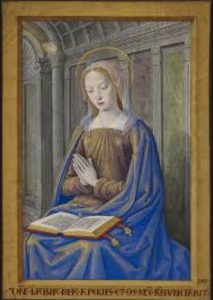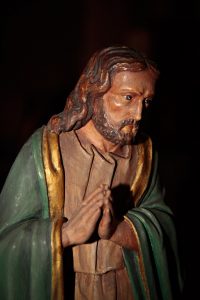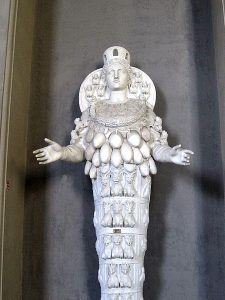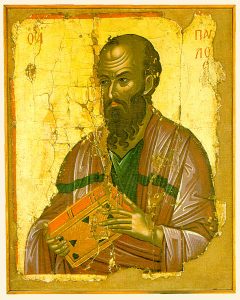In past posts, we have examined women in the first couple of centuries of the Common Era (CE) who may well have been real: Evodia and Syntyche mentioned by Paul in his letter to the Philippians; Apphia, mentioned in Paul’s letter to Philemon;  and women mentioned in Chapter 16 of Paul’s letter to the Romans: Phoebe, Prisca/Priscilla, Mary, Junia, Tryphaena, Tryphosa, Rufus’ mother, Julia, and Nereus’ sister, as well as Persis.
and women mentioned in Chapter 16 of Paul’s letter to the Romans: Phoebe, Prisca/Priscilla, Mary, Junia, Tryphaena, Tryphosa, Rufus’ mother, Julia, and Nereus’ sister, as well as Persis.
Literature of the era produced by various Jesus groups that did not become authorized or canonical also highlighted women, probably fictitious (or loosely based on a real figure but later embellished). Scholars have been able to show that stories about these women can tell us something about the status of women in the early Jesus groups even if they were figments of a writer’s or community’s imagination. These female figures include Anne/Anna/Hannah, Drusiana, and Thecla.
Anne/Anna (Hebrew Hannah). In Christian tradition, Anne (or Anna) is the mother of Mary (mother of Jesus) and the wife of Joachim. Anna, not mentioned in the Christian Testament, is most prominent in the extracanonical texts of the Protevangelium (Infancy Gospel) of James (Protev., second century CE), the Gospel of the Nativity of Mary (Cartlidge and Elliott, 21), and the Gospel of Pseudo-Matthew (Ps-Matt, probably 8th or 9th century CE; Cullmann, 406).  These writings are found primarily in translation and are often fragmentary and thus incomplete; some of this literature is only known through the so-called church fathers, who often showed animosity toward the ideas expressed. It is often almost impossible to know from which communities these writings originated, but they had considerable influence in both the East and West – liturgically and artistically – for centuries. Since the Protev. is the earliest of the writings dealing with Mary and her birth family, scholars believe that it took the outlines of its tales in both the canonical Gospels of Matthew and Luke and the sources from which those Gospels drew their material (Cartlidge and Elliott, 23).
These writings are found primarily in translation and are often fragmentary and thus incomplete; some of this literature is only known through the so-called church fathers, who often showed animosity toward the ideas expressed. It is often almost impossible to know from which communities these writings originated, but they had considerable influence in both the East and West – liturgically and artistically – for centuries. Since the Protev. is the earliest of the writings dealing with Mary and her birth family, scholars believe that it took the outlines of its tales in both the canonical Gospels of Matthew and Luke and the sources from which those Gospels drew their material (Cartlidge and Elliott, 23).
Generally speaking, the main premise in Protev. – that Anna and Joachim brought Mary to be raised in the temple in Jerusalem – is unlikely if not impossible. This discrepancy would not have mattered much to second-century readers or hearers of the story: the main goals of these texts would have been to fill in the gaps of Mary’s early life (even if not factual in our sense of the term) and for her glorification among people becoming known as Christians (Cullmann, 373). As the Christian tradition grew, devotees would have wanted to know about Mary’s parents and upbringing, and depicting her parents – with names – as devout and dedicated would aid in devotion to Mary. By the second century, considerable advances had been made to devotion to Mary, and the Protev. especially “was a powerful factor in the development of Mariology” (Cullmann, 374).
Even if Anna is on the periphery of the Mary stories, she may hold clues to the role of women in the church. In the Protev. (4.1-2), Anna is described as having conceived Mary “without a man’s seed” (parallel to Mary’s conception by the Holy Spirit). Joachim is told that Anna had conceived – but it could not have been by him, since he was in the wilderness at the time.  Bishop Epiphanius of Salamis in the late fourth century did not question that Anna had conceived Mary without a man but did complain that “some people were using this ‘to make her God . . . [or] to make women priestesses’” (Kateusz, 102). Epiphanius lived at a time when we have long been taught that the priesthood was restricted to men, but his comments in relation to Anna imply that he knew of early Christian groups that had women priests, even at this late date.
Bishop Epiphanius of Salamis in the late fourth century did not question that Anna had conceived Mary without a man but did complain that “some people were using this ‘to make her God . . . [or] to make women priestesses’” (Kateusz, 102). Epiphanius lived at a time when we have long been taught that the priesthood was restricted to men, but his comments in relation to Anna imply that he knew of early Christian groups that had women priests, even at this late date.
Drusiana. Drusiana appears in the Acts of John (AJ), which tells tales around the figure of St. John the Evangelist, most likely the same John of the canonical Gospel of John and known by tradition as Jesus’ beloved disciple. Scholars are in some disagreement as to the dating of AJ, from the late second to the third century CE (Cartlidge and Elliott, 6; Schäferdiek, 152-55; Kirby). AJ may have originated in the Syrian region and written in Syriac, but it was widely disseminated in Christian circles by the fourth and later centuries (Schäferdiek, 153-62), and its scenes were depicted in works of art throughout antiquity (Cartlidge and Elliott, 190-96). While John’s mythology has him being exiled to Patmos and dying there peacefully, other traditions maintain that he died a martyr’s death in various ways (“John, St., Apostle;” Cartlidge and Elliott, 193-202), and AJ has him dying peacefully in Ephesus (Schäferdiek, 194, 203-04; Cartlidge and Elliott, 204-05).
 AJ includes the legend of John’s overthrowing of the famous temple of Artemis at Ephesus. We know from archaeological evidence that there was a major temple to Artemis at Ephesus, originally built in the 4th century BCE, destroyed by a Gothic invasion in 267 CE, rebuilt again, then finally destroyed by a Christian mob in 401 CE. Artemis of the Ephesians and its challenge to the early Jesus mission is connected to St. Paul in Acts of the Apostles 19:21-41, and we know that Artemis (Roman Diana) was a prominent deity throughout antiquity for centuries. The legend of John destroying the Ephesian Artemis temple does not make sense from a first-century perspective but could very well reflect an historical reality in the late third century and make sense to the readers of AJ. Of course, AJ promotes the idea that the God of the Christians was victorious over this Graeco-Roman deity.
AJ includes the legend of John’s overthrowing of the famous temple of Artemis at Ephesus. We know from archaeological evidence that there was a major temple to Artemis at Ephesus, originally built in the 4th century BCE, destroyed by a Gothic invasion in 267 CE, rebuilt again, then finally destroyed by a Christian mob in 401 CE. Artemis of the Ephesians and its challenge to the early Jesus mission is connected to St. Paul in Acts of the Apostles 19:21-41, and we know that Artemis (Roman Diana) was a prominent deity throughout antiquity for centuries. The legend of John destroying the Ephesian Artemis temple does not make sense from a first-century perspective but could very well reflect an historical reality in the late third century and make sense to the readers of AJ. Of course, AJ promotes the idea that the God of the Christians was victorious over this Graeco-Roman deity.
Drusiana is the primary female figure in AJ, appearing several times and prominently. The two main aspects of her story are her choosing celibacy and dedication to the Christian God rather than being joined to men and being raised from the dead. Both of these threads – related colorfully in AJ, as other figures are introduced and several places (such as Miletus, Smyrna, and Laodicea, in addition to Ephesus) are visited – are told in order to proclaim the power and success of the Christian message. Some truth that we can glean from the almost entirely fictitious tales of AJ are at least threefold:
- Celibacy, including among women, was a viable lifestyle choice in Christianity. Women who eschewed marriage to become a fellow missionary with others (including men) were courageous in the face of criticism and even threats to their lives, as well as admired by many.
- Healing was a major focus of the religious landscape of antiquity, as we have noted elsewhere. It can be argued that raising the dead can be seen as a kind of healing, and AJ includes a number of examples of raising the dead (as well as one explicit healing story, in passages 56 and 57, of the sons of a Smyrnean man, Antipatros). Drusiana herself raises a man in passages 82-83.

- There is a form of male-female parallelism between John and Drusiana that is similar to other parallelisms, such as that between Mary and Jesus (Kateusz, 101-30): as John has chosen the celibate lifestyle and total dedication to Christ, so does Drusiana. In other words, there were strands in the early church that viewed men and women as equal in the mission – just as Paul did in the first century (see especially Vearncombe et al, 128).
Thecla. We discussed some aspects of the Thecla story earlier. Found in the popular late second-century apocryphal book, The Acts of Paul and Thecla, the story includes a number of adventures: Thecla’s conversion to Christianity after hearing St. Paul preach; her decision not to go through with her marriage, thus angering her fiance and her mother; their attempts to harm both Thecla and Paul and having Paul imprisoned; Paul’s escape and his taking Thecla with him to Antioch; a man Alexander falling in love with Thecla and her rebuffing him; his bringing a complaint against her and the governor condemning her to death; her miraculous rescue from the beasts in the arena; and her throwing herself into water in self-baptism.
Thecla then finds support from a powerful woman, Tryphaena; Thecla teaches her and her servants in the Christian faith and develops a following among women, who are converted and support her (Schneemelcher, 240-46). This aspect of the story in particular bothers the church father Tertullian: in de Baptismo, he criticizes those women who cite the Acts of Paul as supporting the right of women to teach and baptize. This further supports the argument that women were in fact teaching and baptizing at this time in church history, contrary to the wishes of many powerful male church leaders and contrary to what we have been led to believe (Schneemelcher, 214; Streete, 347).
Conclusion
As we saw when we examined the figure of Salome, the midwife in the Protev., there are a number of observations we can make about the early Jesus movement and especially about real women of the movement and even well into the first few centuries CE:
- Early Christianity, as revealed in its vast quantity of literature, was very diverse vis-à-vis how it understood Jesus and his message (Vearncombe et al, 214, 246 and passim).
- Women were integral to the early Jesus mission and often served in leadership roles. The argument can certainly be made that the movement tested gender boundaries, which seems to have led some communities to treat women as equals with men (Vearncombe et al, 115-29).
- The apocryphal literature can offer a window into the relationship between the Jesus movement and Graeco-Roman deities, especially female goddesses and their cults.
Authors of ancient literature and creators of art based on this literature have reasons for depicting women (and other characters) the way they do, including inventing fictitious individuals. We could take the position that fictitious figures and their stories should be dismissed, that they have little or no value in our investigation of the early Roman Empire. We must definitely read these stories and view this art with a degree of skepticism, if we are searching for facts, but by reading between the lines and exploring the archaeological, sociological and political context of these tales can provide us with information that can move our knowledge forward.
Resources
Cardman, Francine. “Women, Ministry, and Church Order in Early Christianity,” in Ross Shepard Kraemer and Mary Rose D’Angelo, eds., Women and Christian Origins, 300-29, New York and Oxford: Oxford University Press, 1999.
Cartlidge, David R. and J. Keith Elliott. Art and the Christian Apocrypha. London and New York: Routledge, 2001.
Cullmann, Oscar. “Infancy Gospels,” in Wilhelm Schneemelcher, ed., New Testament Apocrypha. Vol. One: Gospels and Related Writings, 363-401. English translation edited by Robert McL. Wilson. Philadelphia: The Westminster Press, 1963. First published in German, Tübingen: J.C.B. Mohr, 1959.
“John, Acts of,” in F.L. Cross and E.A. Livingstone, eds., The Oxford Dictionary of the Christian Church, Second Edition, 742. Oxford: Oxford University Press, 1988.
“John, St., Apostle,” in F.L. Cross and E.A. Livingstone, eds., The Oxford Dictionary of the Christian Church, Second Edition, 742. Oxford: Oxford University Press, 1988.
Kateusz, Ally. Mary and Early Christian Women: Hidden Leadership. London: Palgrave Macmillan, 2019.
McGuire, Anne. “Women, Gender, and Gnosis in Gnostic Texts and Traditions,” in Ross Shepard Kraemer and Mary Rose D’Angelo, eds., Women and Christian Origins, 257-99. New York and Oxford: Oxford University Press, 1999.
Schäferdiek, Knut, “The Acts of John,” in Wilhelm Schneemelcher, ed., New Testament Apocrypha. Vol. Two: Writings Relating to the Apostles: Apocalypses and Related Subjects, revised ed., 152-212. Cambridge: James Clarke and Co., Westminster/John Knox Press, 1992.
Streete, Gail Corrington. “Women as Sources of Redemption and Knowledge in Early Christian Traditions,” in Ross Shepard Kraemer and Mary Rose D’Angelo, eds., Women and Christian Origins, 330-54. New York and Oxford: Oxford University Press, 1999
Vearncombe, Erin, Brandon Scott, and Hal Taussig. After Jesus Before Christianity: A Historical Exploration of the First Two Centuries of Jesus Movements. New York: HarperCollins Publishers, 2021.
